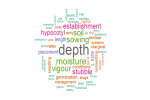In southern Australia, where lentils mature into terminal drought, acute heat stress (compounded by water stress and hot northerly winds) can cause yield losses of up to 70 per cent. Analysis of the performance of lentil lines within the 2008–19 National Variety Trials found that average grain yield declines by two per cent for every degree above 30oC.
The average annual yield lost to acute heat stress has been estimated at 1.5 tonnes per hectare (based on a yield potential of 3.1t/ha). Additional studies found that acute high-temperature heat tolerance in Australian cultivars is generally poor, except for PBA Bolt and Nipper.
A concerted effort is now underway to apply the SmartFarm’s new advanced screening and trait-selection technology to identify more acute high-temperature heat-tolerant lentil material and tools that allow breeders to select for this trait.
Technology platforms
Heading this program is Dr Sukhjiwan Kaur (research leader – applied genomics and predictive breeding). She has a set of technology platforms in place at the Horsham SmartFarm and the AgriBio Centre for AgriBioscience in Bundoora that will enable rapid genetic gain.
 Research leader Dr Sukhjiwan Kaur. Photo: AgVic
Research leader Dr Sukhjiwan Kaur. Photo: AgVic
This project will screen 500 highly diverse lentil lines. Lines were selected from the Australian Grains Genebank (AGG) to maximise the chance of identifying useful genetic variation in heat tolerance.
“In the first two years, we screened advanced breeding material and existing Australian cultivars to better understand the level of variation for heat tolerance that is already present in Australian adapted material,” Dr Kaur says.
“In 2024, 500 diverse lines were evaluated at Hopetoun in field trials using a normal and late sowing regime to understand the impact of higher end-of-season temperatures on yield. Two hundred of these lines were also screened in field trials at Narrabri (NSW) and Merredin (WA).”
The very best of this material will then be funnelled through a series of phenotypic screens to validate their responses to acute high-temperature stress.
This will include deploying purpose-built heat chambers in the field and using the new, globally unique Free Air Temperature Extreme (FATE) facility at the Horsham SmartFarm.
Heat chambers
FATE uses mobile trolleys with computer-controlled infrared heaters in the field to control ambient temperature over the crop canopy.
Through precise temperature control, heatwaves experienced in growers’ fields can be accurately mimicked at the trial site. These precision heat chambers were developed by Dr Ashley Wallace and Dr Audrey Delahunty and FATE was developed by Associate Professor Glenn Fitzgerald.
“This level of control enables a deeper probing of genotype-by-heat-by-water interactions and allows for the selection of more sophisticated heat tolerance trait combinations,” Dr Kaur says.
Useful genetics for acute high-temperature stress tolerance will be combined using the AI-driven genomic prediction technology. The accelerated breeding facility will then be used to fast-track the development of improved germplasm, with seed stocks delivered to lentil breeders nationally.
This process enables the rapid development of lentil lines that are bred to contain the phenology, agronomic and regional adaption traits required by the breeders. This results in what Dr Kaur calls “locally adapted breeder-friendly lines”.
In addition, we have work underway to phenotype the lentil germplasm for other properties such as marketability and nutritional and milling traits.
“That means we should end up with a lot of relevant information at the end of the project,” Dr Kaur says.
This work is a collaboration with the University of Sydney.
Lentils lead the way for pulse varietal classification
While Australian varietal classification systems for wheat and barley varieties are well established, classification frameworks for pulses, including lentils, have not previously existed.
That has changed with Grains Australia, an initiative of GRDC, leading the development of a new lentil variety classification framework that will guide the establishment of varietal classification frameworks for other pulse crops.
Grains Australia classification general manager Dr Megan Sheehy says the aim was to add value to Australia’s lentil industry by enabling differentiation of varieties based on quality characteristics desired by customers.
It’s about providing ‘goalposts’ for pulse breeders to ensure that varieties produced will meet market demands and opportunities.
“Development of the lentil framework had been overseen by a Grains Australia steering committee. The framework is a starting point and Grains Australia, through its Pulse Council, will review and update it on an ongoing basis,” she says.
This may include additional classification criteria and traits in the future. The framework is currently for red lentils only as these comprise the vast majority of lentils produced and traded by Australia, with the remainder being green lentils.
Dr Sheehy says the next steps are for Grains Australia to work with key stakeholders to implement the framework and develop associated procedures and processes, including requirements for breeders.
“Grains Australia’s development of the lentil variety classification framework is part of its responsibility for establishing and maintaining grain variety classification systems in Australia,” Dr Sheehy says.
“Grains Australia is responsible for vital industry services and functions that improve the industry’s competitiveness and profitability. In addition to classification, these services and functions include trade and market access and market insights and education.”
More information: Visit the Grains Australia website.
Resources: read GroundCover Supplement stories Lentil breeding on turbocharge and Overcoming acid soils.

























































